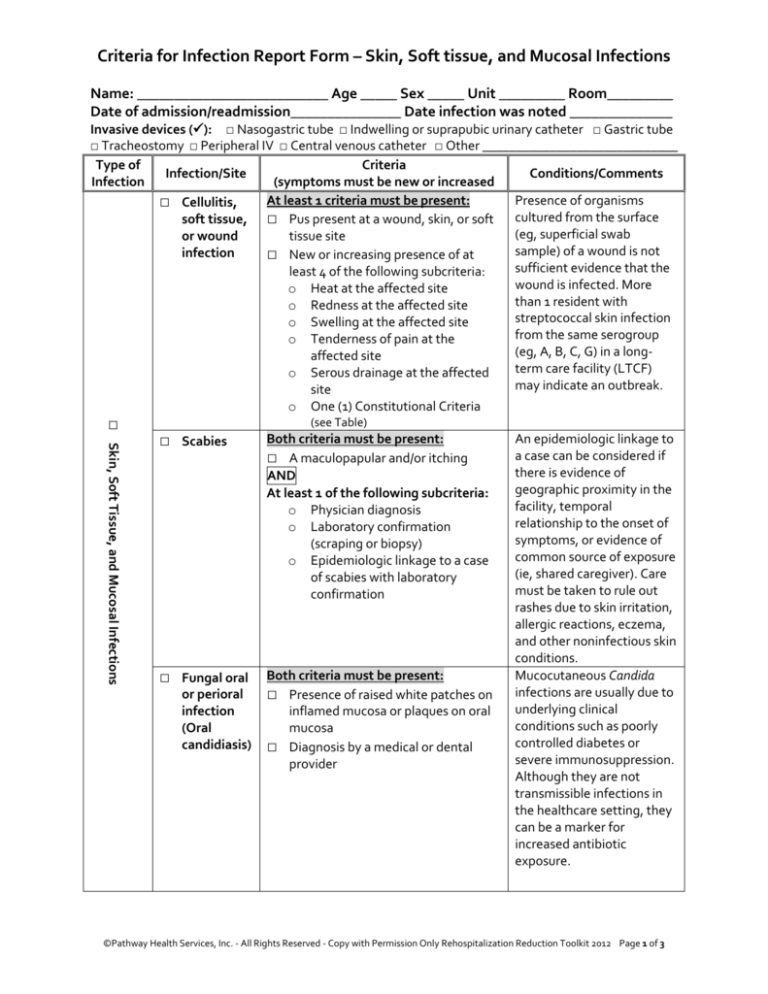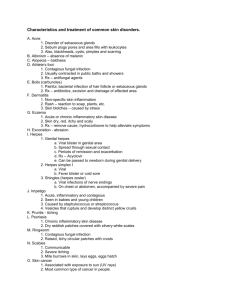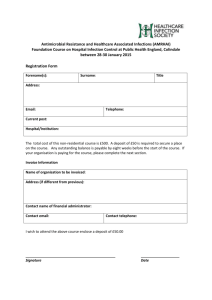
Criteria for Infection Report Form – Skin, Soft tissue, and Mucosal Infections
Name: __________________________ Age _____ Sex _____ Unit _________ Room_________
Date of admission/readmission_______________ Date infection was noted ______________
Invasive devices (): □ Nasogastric tube □ Indwelling or suprapubic urinary catheter □ Gastric tube
□ Tracheostomy □ Peripheral IV □ Central venous catheter □ Other _____________________________
Type of
Criteria
Infection/Site
Conditions/Comments
Infection
(symptoms must be new or increased
At least 1 criteria must be present:
Presence of organisms
□ Cellulitis,
cultured from the surface
soft tissue, □ Pus present at a wound, skin, or soft
(eg, superficial swab
or wound
tissue site
sample) of a wound is not
infection
□ New or increasing presence of at
sufficient evidence that the
least 4 of the following subcriteria:
wound is infected. More
o Heat at the affected site
than 1 resident with
o Redness at the affected site
streptococcal skin infection
o Swelling at the affected site
from the same serogroup
o Tenderness of pain at the
(eg, A, B, C, G) in a longaffected site
term care facility (LTCF)
o Serous drainage at the affected
may indicate an outbreak.
site
o One (1) Constitutional Criteria
□ Skin, Soft Tissue, and Mucosal Infections
(see Table)
□ Scabies
Both criteria must be present:
□ A maculopapular and/or itching
AND
At least 1 of the following subcriteria:
o Physician diagnosis
o Laboratory confirmation
(scraping or biopsy)
o Epidemiologic linkage to a case
of scabies with laboratory
confirmation
□ Fungal oral
or perioral
infection
(Oral
candidiasis)
Both criteria must be present:
□ Presence of raised white patches on
inflamed mucosa or plaques on oral
mucosa
□ Diagnosis by a medical or dental
provider
An epidemiologic linkage to
a case can be considered if
there is evidence of
geographic proximity in the
facility, temporal
relationship to the onset of
symptoms, or evidence of
common source of exposure
(ie, shared caregiver). Care
must be taken to rule out
rashes due to skin irritation,
allergic reactions, eczema,
and other noninfectious skin
conditions.
Mucocutaneous Candida
infections are usually due to
underlying clinical
conditions such as poorly
controlled diabetes or
severe immunosuppression.
Although they are not
transmissible infections in
the healthcare setting, they
can be a marker for
increased antibiotic
exposure.
©Pathway Health Services, Inc. - All Rights Reserved - Copy with Permission Only Rehospitalization Reduction Toolkit 2012 Page 1 of 3
Criteria for Infection Report Form – Skin, Soft tissue, and Mucosal Infections
Type of
Infection
Infection/Site
□ Fungal skin
infection
□ Skin, Soft Tissue, and Mucosal Infections
Criteria
(symptoms must be new or increased
Both criteria must be present:
□ Characteristic rash or lesions
□ Either a diagnosis by a medical
provider or a laboratory-confirmed
fungal pathogen from a scraping or
a medical biopsy
□ Herpes virus
skin
infections
(Herpes
simplex)
Both criteria must be present:
□ A vesicular rash
□ Either physician diagnosis or
laboratory confirmation
□ Herpes virus
skin
infections
(Herpes
zoster)
Both criteria must be present:
□ A vesicular rash
□ Either physician diagnosis or
laboratory confirmation
□ Conjunctivitis At least 1 criteria must be present:
□ Pus appearing from 1 or both eyes,
present for at least 24 hours
□ New or increased conjunctival
erythema, with or without itching
□ New or increased conjunctival pain,
present for at least 24 hours
Conditions/Comments
Dermatophytes (a parasitic
fungus that affects the skin,
hair, or nails) have been
known to cause occasional
infections and rare
outbreaks in the LTCF
setting.
Reactivation of herpes
simplex (“cold sores”) or
herpes zoster (“shingles”) is
not considered a
healthcare-associated
infection. Primary herpes
virus skin infections are very
uncommon in a LTCF
except in pediatric
populations, where it
should be considered
healthcare associated.
Conjunctivitis symptoms
(“pink eye”) should not be
due to allergic reaction or
trauma.
NOTE: For wound infections related to surgical procedures, LTCFs should use the Centers for Disease
Control and Prevention’s National Healthcare Safety Network Surgical Site Infection criteria and report
these infections back to the institution where the original surgery was performed.
©Pathway Health Services, Inc. - All Rights Reserved - Copy with Permission Only Rehospitalization Reduction Toolkit 2012 Page 2 of 3
Criteria for Infection Report Form – Skin, Soft tissue, and Mucosal Infections
1. Was resident hospitalized due to this infection?
□ Yes
□ No
2. Culture results (if any):
DATE:
SITE:
ORGANISM(S):
COMMENTS:
DATE:
SITE:
ORGANISM(S):
COMMENTS:
DATE:
SITE:
ORGANISM(S):
COMMENTS:
3. Outcome; at end of infection, the resident was:
□ The same or better than before infection
□ More dependent that before infection
□ Transferred to another facility
□ Expired/deceased
4. Does resident have a multi-drug resistant organism on culture (eg, MRSA, VRE)?
□ Yes
□ No
5. If yes, type:
□ MRSA
□ VRE
□ C-Diff
□ Other:___________________________________
6. If culture positive for multi-drug resistant organism, do they meet criteria for infection
at the site of positive culture?
□ Yes
□ No (If no, resident is likely only colonized and not infected. Isolation or contact
precautions may be necessary.)
Comments:_____________________________________________________________________
_______________________________________________________________________________
_______________________________________________________________________________
_______________________________________________________________________________
Completed by:_________________________________ Title:____________ Date:___________
Source: Infection Control and Hospital Epidemiology 2012;33(10):965-977
©Pathway Health Services, Inc. - All Rights Reserved - Copy with Permission Only Rehospitalization Reduction Toolkit 2012 Page 3 of 3






